Management Accounting Report: Galway Plc Financial Analysis
VerifiedAdded on 2023/01/23
|18
|4451
|27
Report
AI Summary
This report provides a comprehensive analysis of management accounting systems for Galway Plc, a manufacturing firm. It begins by defining management accounting and its importance in decision-making, then delves into different types of systems like cost accounting, inventory management, and job costing, outlining their essential requirements. The report explores various management accounting reporting methods, including performance, cost managerial, budget, and accounts receivable aging reports, and discusses their benefits. It then presents a detailed calculation of income statements under both marginal and absorption costing methods for Galway Plc, including interpretations of the results. The report also defines and analyzes the advantages and disadvantages of different budgetary control planning tools, such as flexible budgets. Finally, it examines how management accounting techniques can be used to resolve financial problems within the organization, providing a complete overview of financial management strategies.
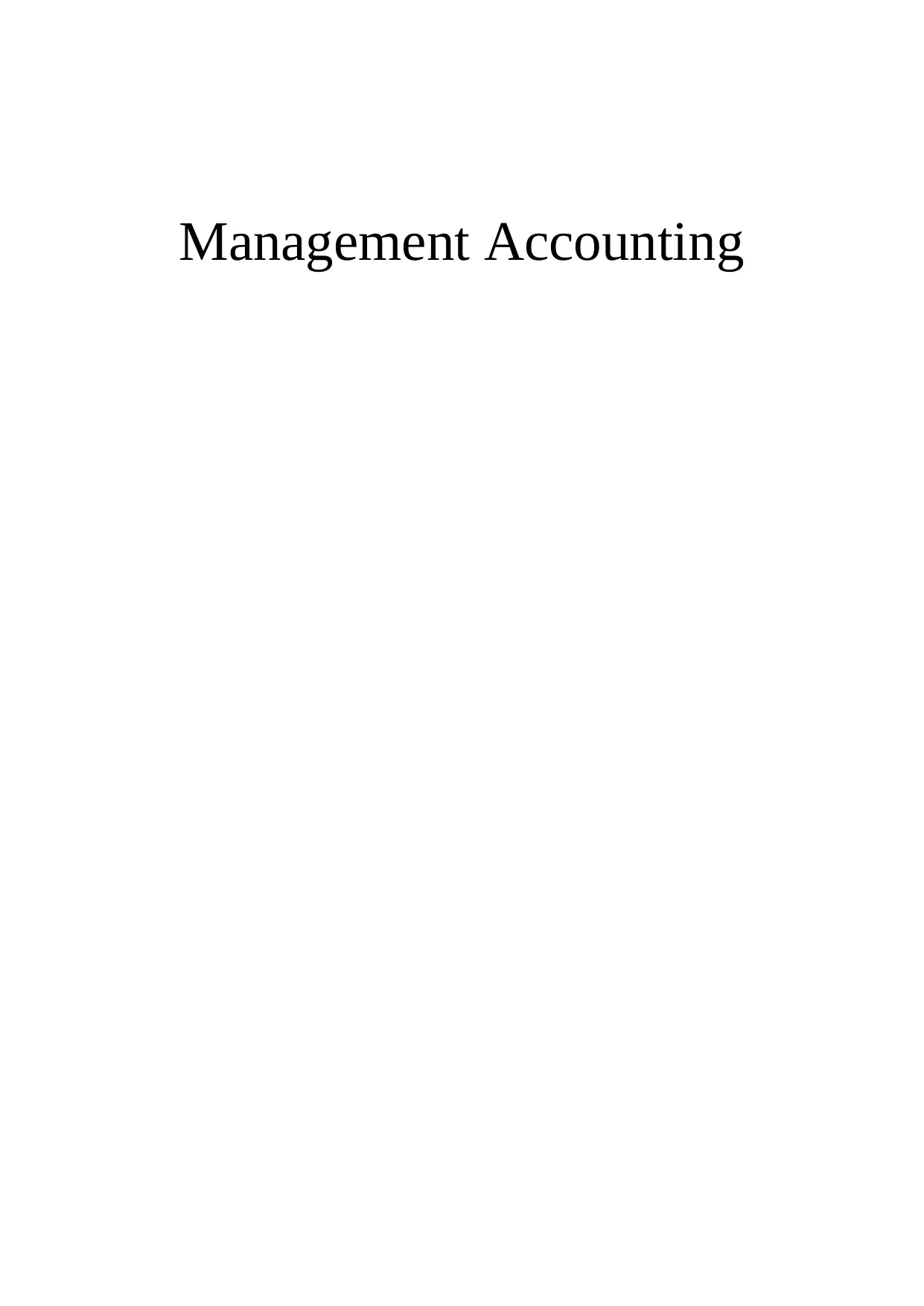
Management Accounting
Paraphrase This Document
Need a fresh take? Get an instant paraphrase of this document with our AI Paraphraser
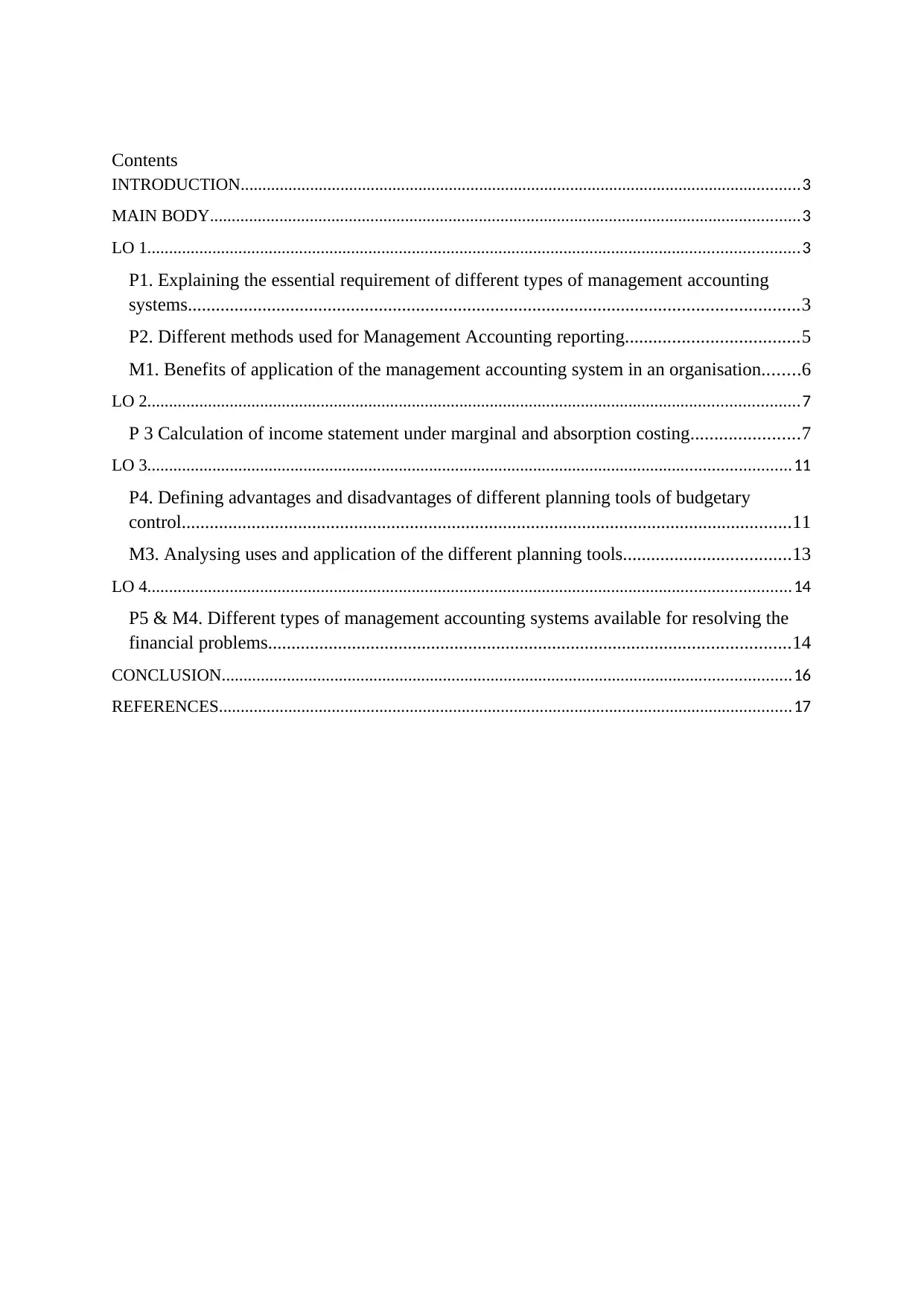
Contents
INTRODUCTION.................................................................................................................................3
MAIN BODY........................................................................................................................................3
LO 1......................................................................................................................................................3
P1. Explaining the essential requirement of different types of management accounting
systems...................................................................................................................................3
P2. Different methods used for Management Accounting reporting.....................................5
M1. Benefits of application of the management accounting system in an organisation........6
LO 2......................................................................................................................................................7
P 3 Calculation of income statement under marginal and absorption costing.......................7
LO 3....................................................................................................................................................11
P4. Defining advantages and disadvantages of different planning tools of budgetary
control...................................................................................................................................11
M3. Analysing uses and application of the different planning tools....................................13
LO 4....................................................................................................................................................14
P5 & M4. Different types of management accounting systems available for resolving the
financial problems................................................................................................................14
CONCLUSION...................................................................................................................................16
REFERENCES....................................................................................................................................17
INTRODUCTION.................................................................................................................................3
MAIN BODY........................................................................................................................................3
LO 1......................................................................................................................................................3
P1. Explaining the essential requirement of different types of management accounting
systems...................................................................................................................................3
P2. Different methods used for Management Accounting reporting.....................................5
M1. Benefits of application of the management accounting system in an organisation........6
LO 2......................................................................................................................................................7
P 3 Calculation of income statement under marginal and absorption costing.......................7
LO 3....................................................................................................................................................11
P4. Defining advantages and disadvantages of different planning tools of budgetary
control...................................................................................................................................11
M3. Analysing uses and application of the different planning tools....................................13
LO 4....................................................................................................................................................14
P5 & M4. Different types of management accounting systems available for resolving the
financial problems................................................................................................................14
CONCLUSION...................................................................................................................................16
REFERENCES....................................................................................................................................17
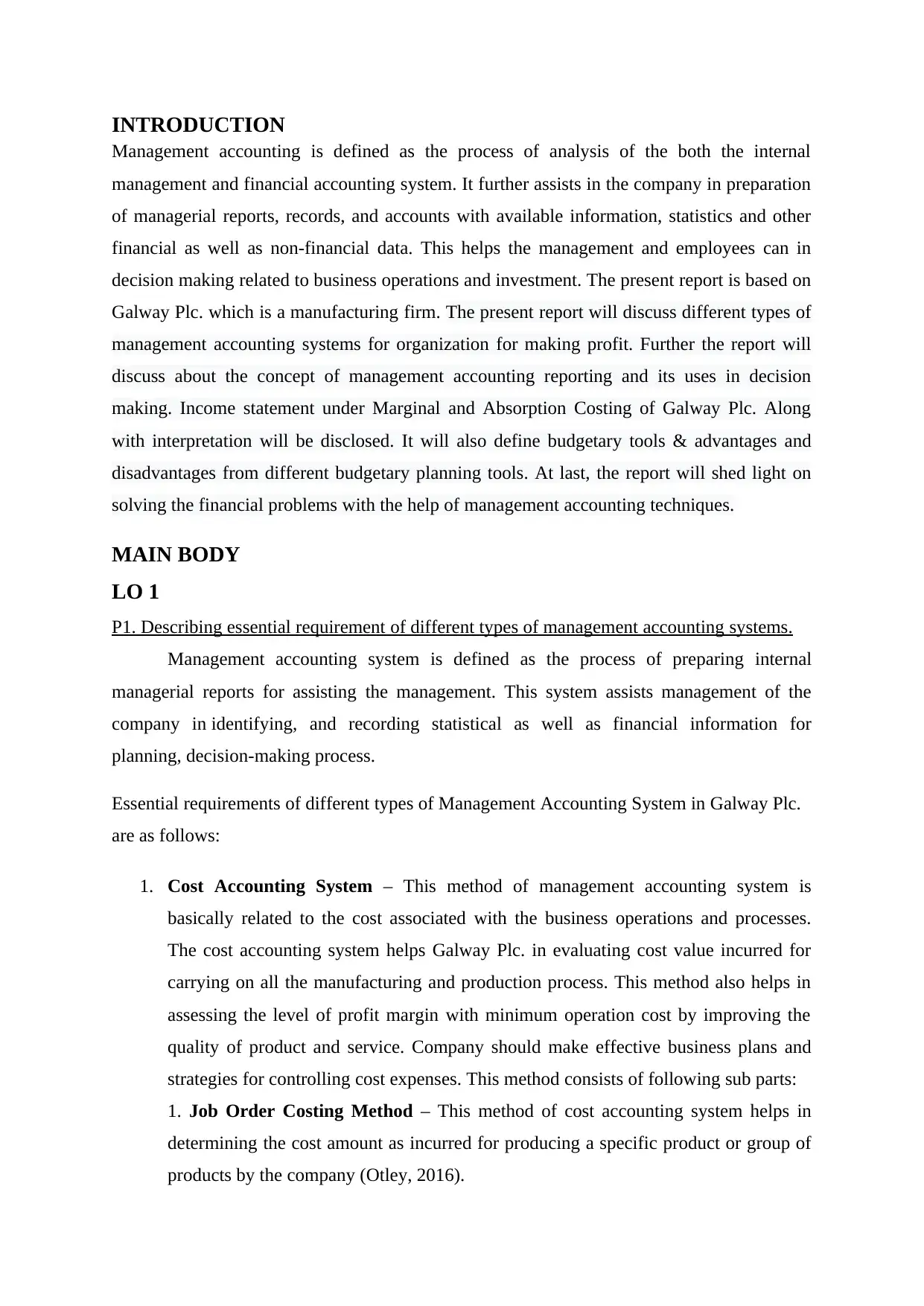
INTRODUCTION
Management accounting is defined as the process of analysis of the both the internal
management and financial accounting system. It further assists in the company in preparation
of managerial reports, records, and accounts with available information, statistics and other
financial as well as non-financial data. This helps the management and employees can in
decision making related to business operations and investment. The present report is based on
Galway Plc. which is a manufacturing firm. The present report will discuss different types of
management accounting systems for organization for making profit. Further the report will
discuss about the concept of management accounting reporting and its uses in decision
making. Income statement under Marginal and Absorption Costing of Galway Plc. Along
with interpretation will be disclosed. It will also define budgetary tools & advantages and
disadvantages from different budgetary planning tools. At last, the report will shed light on
solving the financial problems with the help of management accounting techniques.
MAIN BODY
LO 1
P1. Describing essential requirement of different types of management accounting systems.
Management accounting system is defined as the process of preparing internal
managerial reports for assisting the management. This system assists management of the
company in identifying, and recording statistical as well as financial information for
planning, decision-making process.
Essential requirements of different types of Management Accounting System in Galway Plc.
are as follows:
1. Cost Accounting System – This method of management accounting system is
basically related to the cost associated with the business operations and processes.
The cost accounting system helps Galway Plc. in evaluating cost value incurred for
carrying on all the manufacturing and production process. This method also helps in
assessing the level of profit margin with minimum operation cost by improving the
quality of product and service. Company should make effective business plans and
strategies for controlling cost expenses. This method consists of following sub parts:
1. Job Order Costing Method – This method of cost accounting system helps in
determining the cost amount as incurred for producing a specific product or group of
products by the company (Otley, 2016).
Management accounting is defined as the process of analysis of the both the internal
management and financial accounting system. It further assists in the company in preparation
of managerial reports, records, and accounts with available information, statistics and other
financial as well as non-financial data. This helps the management and employees can in
decision making related to business operations and investment. The present report is based on
Galway Plc. which is a manufacturing firm. The present report will discuss different types of
management accounting systems for organization for making profit. Further the report will
discuss about the concept of management accounting reporting and its uses in decision
making. Income statement under Marginal and Absorption Costing of Galway Plc. Along
with interpretation will be disclosed. It will also define budgetary tools & advantages and
disadvantages from different budgetary planning tools. At last, the report will shed light on
solving the financial problems with the help of management accounting techniques.
MAIN BODY
LO 1
P1. Describing essential requirement of different types of management accounting systems.
Management accounting system is defined as the process of preparing internal
managerial reports for assisting the management. This system assists management of the
company in identifying, and recording statistical as well as financial information for
planning, decision-making process.
Essential requirements of different types of Management Accounting System in Galway Plc.
are as follows:
1. Cost Accounting System – This method of management accounting system is
basically related to the cost associated with the business operations and processes.
The cost accounting system helps Galway Plc. in evaluating cost value incurred for
carrying on all the manufacturing and production process. This method also helps in
assessing the level of profit margin with minimum operation cost by improving the
quality of product and service. Company should make effective business plans and
strategies for controlling cost expenses. This method consists of following sub parts:
1. Job Order Costing Method – This method of cost accounting system helps in
determining the cost amount as incurred for producing a specific product or group of
products by the company (Otley, 2016).
⊘ This is a preview!⊘
Do you want full access?
Subscribe today to unlock all pages.

Trusted by 1+ million students worldwide
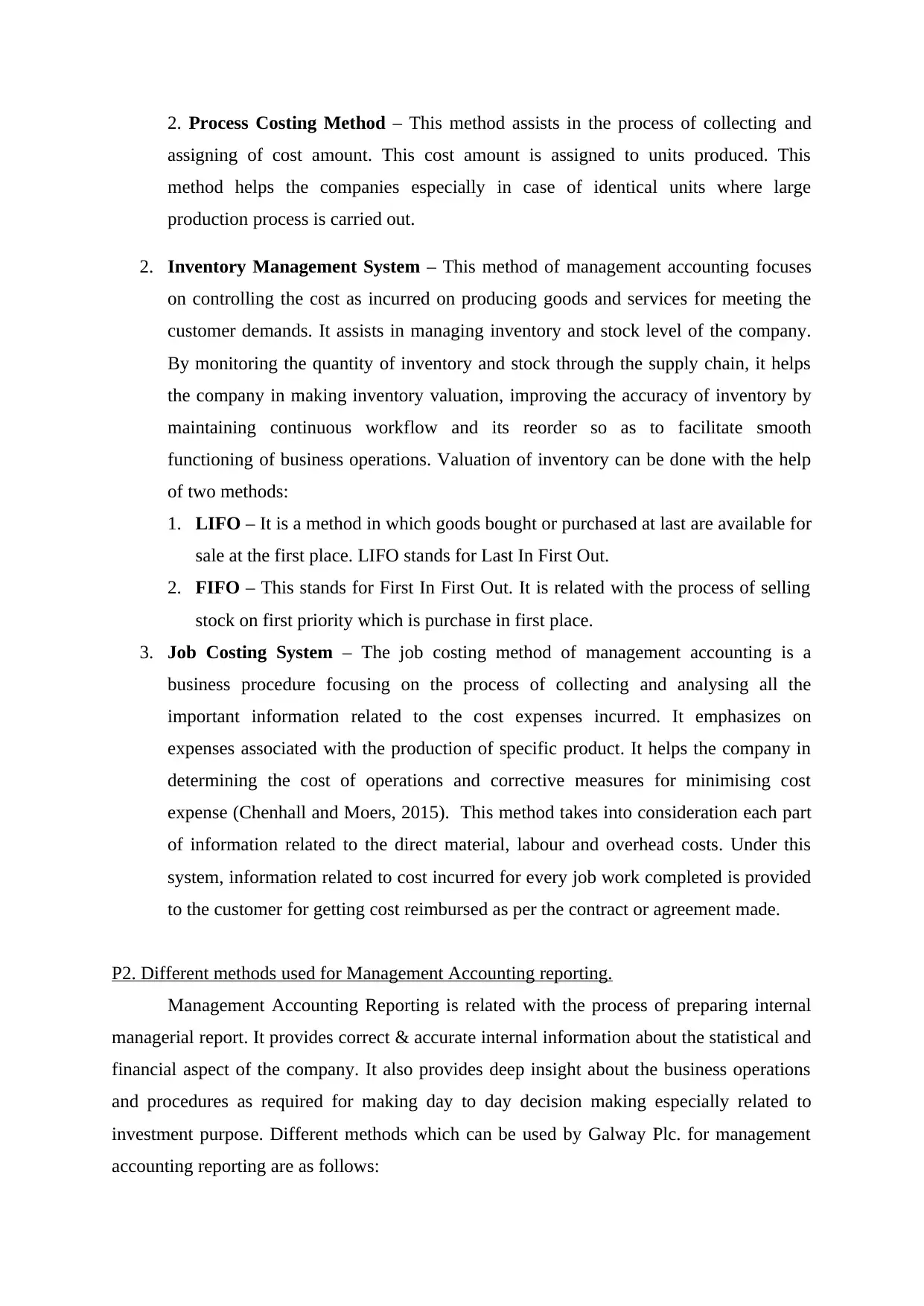
2. Process Costing Method – This method assists in the process of collecting and
assigning of cost amount. This cost amount is assigned to units produced. This
method helps the companies especially in case of identical units where large
production process is carried out.
2. Inventory Management System – This method of management accounting focuses
on controlling the cost as incurred on producing goods and services for meeting the
customer demands. It assists in managing inventory and stock level of the company.
By monitoring the quantity of inventory and stock through the supply chain, it helps
the company in making inventory valuation, improving the accuracy of inventory by
maintaining continuous workflow and its reorder so as to facilitate smooth
functioning of business operations. Valuation of inventory can be done with the help
of two methods:
1. LIFO – It is a method in which goods bought or purchased at last are available for
sale at the first place. LIFO stands for Last In First Out.
2. FIFO – This stands for First In First Out. It is related with the process of selling
stock on first priority which is purchase in first place.
3. Job Costing System – The job costing method of management accounting is a
business procedure focusing on the process of collecting and analysing all the
important information related to the cost expenses incurred. It emphasizes on
expenses associated with the production of specific product. It helps the company in
determining the cost of operations and corrective measures for minimising cost
expense (Chenhall and Moers, 2015). This method takes into consideration each part
of information related to the direct material, labour and overhead costs. Under this
system, information related to cost incurred for every job work completed is provided
to the customer for getting cost reimbursed as per the contract or agreement made.
P2. Different methods used for Management Accounting reporting.
Management Accounting Reporting is related with the process of preparing internal
managerial report. It provides correct & accurate internal information about the statistical and
financial aspect of the company. It also provides deep insight about the business operations
and procedures as required for making day to day decision making especially related to
investment purpose. Different methods which can be used by Galway Plc. for management
accounting reporting are as follows:
assigning of cost amount. This cost amount is assigned to units produced. This
method helps the companies especially in case of identical units where large
production process is carried out.
2. Inventory Management System – This method of management accounting focuses
on controlling the cost as incurred on producing goods and services for meeting the
customer demands. It assists in managing inventory and stock level of the company.
By monitoring the quantity of inventory and stock through the supply chain, it helps
the company in making inventory valuation, improving the accuracy of inventory by
maintaining continuous workflow and its reorder so as to facilitate smooth
functioning of business operations. Valuation of inventory can be done with the help
of two methods:
1. LIFO – It is a method in which goods bought or purchased at last are available for
sale at the first place. LIFO stands for Last In First Out.
2. FIFO – This stands for First In First Out. It is related with the process of selling
stock on first priority which is purchase in first place.
3. Job Costing System – The job costing method of management accounting is a
business procedure focusing on the process of collecting and analysing all the
important information related to the cost expenses incurred. It emphasizes on
expenses associated with the production of specific product. It helps the company in
determining the cost of operations and corrective measures for minimising cost
expense (Chenhall and Moers, 2015). This method takes into consideration each part
of information related to the direct material, labour and overhead costs. Under this
system, information related to cost incurred for every job work completed is provided
to the customer for getting cost reimbursed as per the contract or agreement made.
P2. Different methods used for Management Accounting reporting.
Management Accounting Reporting is related with the process of preparing internal
managerial report. It provides correct & accurate internal information about the statistical and
financial aspect of the company. It also provides deep insight about the business operations
and procedures as required for making day to day decision making especially related to
investment purpose. Different methods which can be used by Galway Plc. for management
accounting reporting are as follows:
Paraphrase This Document
Need a fresh take? Get an instant paraphrase of this document with our AI Paraphraser
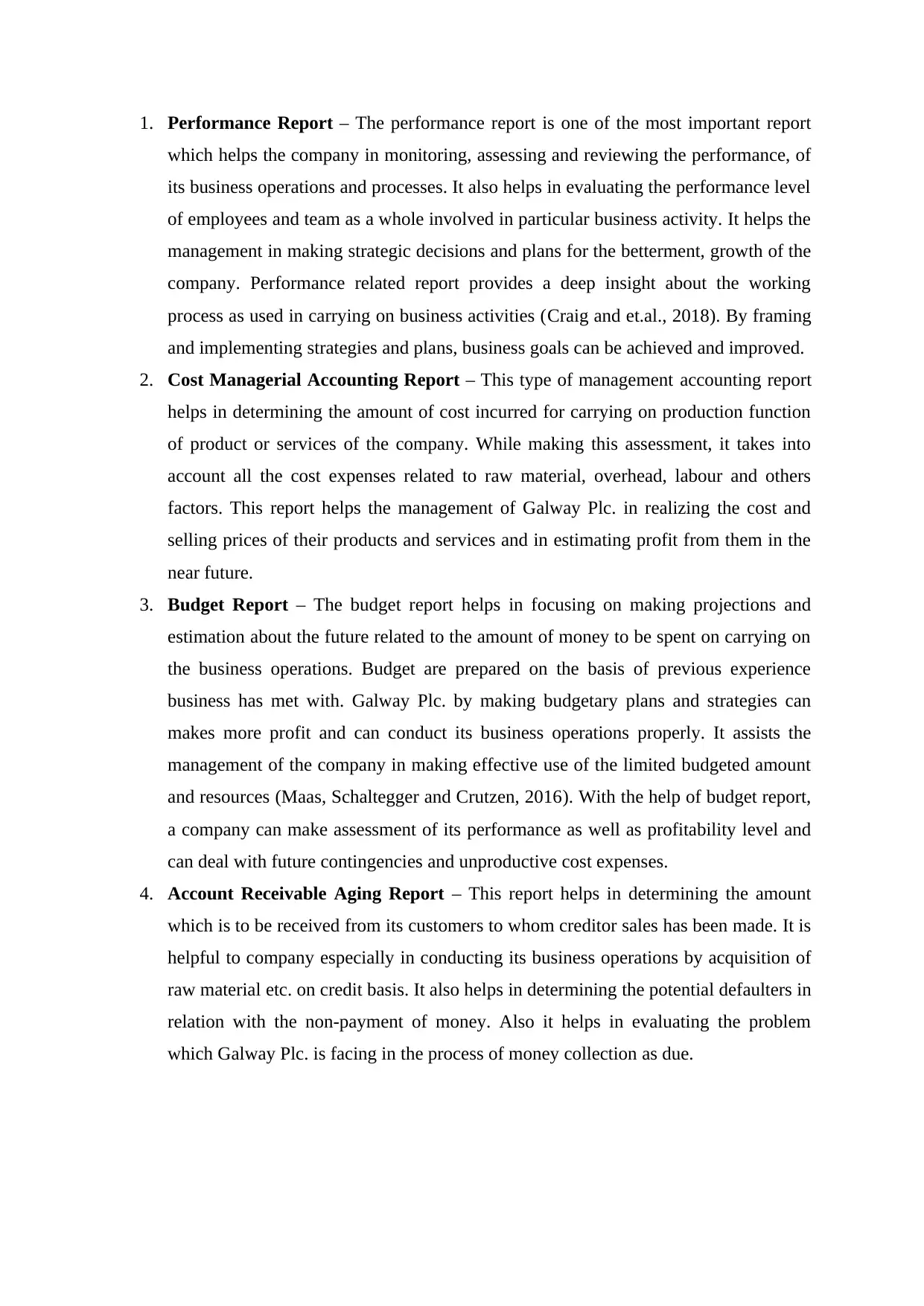
1. Performance Report – The performance report is one of the most important report
which helps the company in monitoring, assessing and reviewing the performance, of
its business operations and processes. It also helps in evaluating the performance level
of employees and team as a whole involved in particular business activity. It helps the
management in making strategic decisions and plans for the betterment, growth of the
company. Performance related report provides a deep insight about the working
process as used in carrying on business activities (Craig and et.al., 2018). By framing
and implementing strategies and plans, business goals can be achieved and improved.
2. Cost Managerial Accounting Report – This type of management accounting report
helps in determining the amount of cost incurred for carrying on production function
of product or services of the company. While making this assessment, it takes into
account all the cost expenses related to raw material, overhead, labour and others
factors. This report helps the management of Galway Plc. in realizing the cost and
selling prices of their products and services and in estimating profit from them in the
near future.
3. Budget Report – The budget report helps in focusing on making projections and
estimation about the future related to the amount of money to be spent on carrying on
the business operations. Budget are prepared on the basis of previous experience
business has met with. Galway Plc. by making budgetary plans and strategies can
makes more profit and can conduct its business operations properly. It assists the
management of the company in making effective use of the limited budgeted amount
and resources (Maas, Schaltegger and Crutzen, 2016). With the help of budget report,
a company can make assessment of its performance as well as profitability level and
can deal with future contingencies and unproductive cost expenses.
4. Account Receivable Aging Report – This report helps in determining the amount
which is to be received from its customers to whom creditor sales has been made. It is
helpful to company especially in conducting its business operations by acquisition of
raw material etc. on credit basis. It also helps in determining the potential defaulters in
relation with the non-payment of money. Also it helps in evaluating the problem
which Galway Plc. is facing in the process of money collection as due.
which helps the company in monitoring, assessing and reviewing the performance, of
its business operations and processes. It also helps in evaluating the performance level
of employees and team as a whole involved in particular business activity. It helps the
management in making strategic decisions and plans for the betterment, growth of the
company. Performance related report provides a deep insight about the working
process as used in carrying on business activities (Craig and et.al., 2018). By framing
and implementing strategies and plans, business goals can be achieved and improved.
2. Cost Managerial Accounting Report – This type of management accounting report
helps in determining the amount of cost incurred for carrying on production function
of product or services of the company. While making this assessment, it takes into
account all the cost expenses related to raw material, overhead, labour and others
factors. This report helps the management of Galway Plc. in realizing the cost and
selling prices of their products and services and in estimating profit from them in the
near future.
3. Budget Report – The budget report helps in focusing on making projections and
estimation about the future related to the amount of money to be spent on carrying on
the business operations. Budget are prepared on the basis of previous experience
business has met with. Galway Plc. by making budgetary plans and strategies can
makes more profit and can conduct its business operations properly. It assists the
management of the company in making effective use of the limited budgeted amount
and resources (Maas, Schaltegger and Crutzen, 2016). With the help of budget report,
a company can make assessment of its performance as well as profitability level and
can deal with future contingencies and unproductive cost expenses.
4. Account Receivable Aging Report – This report helps in determining the amount
which is to be received from its customers to whom creditor sales has been made. It is
helpful to company especially in conducting its business operations by acquisition of
raw material etc. on credit basis. It also helps in determining the potential defaulters in
relation with the non-payment of money. Also it helps in evaluating the problem
which Galway Plc. is facing in the process of money collection as due.
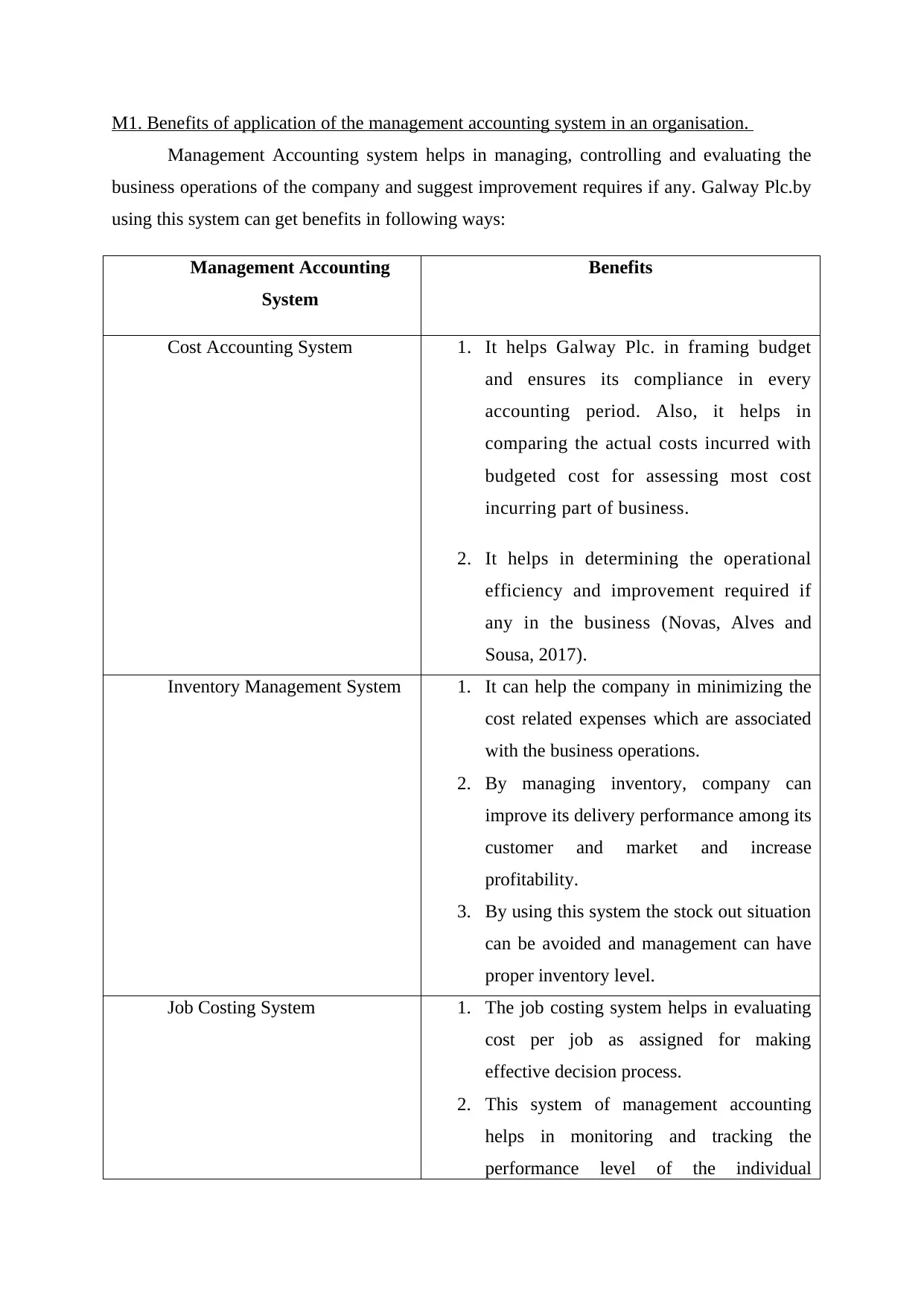
M1. Benefits of application of the management accounting system in an organisation.
Management Accounting system helps in managing, controlling and evaluating the
business operations of the company and suggest improvement requires if any. Galway Plc.by
using this system can get benefits in following ways:
Management Accounting
System
Benefits
Cost Accounting System 1. It helps Galway Plc. in framing budget
and ensures its compliance in every
accounting period. Also, it helps in
comparing the actual costs incurred with
budgeted cost for assessing most cost
incurring part of business.
2. It helps in determining the operational
efficiency and improvement required if
any in the business (Novas, Alves and
Sousa, 2017).
Inventory Management System 1. It can help the company in minimizing the
cost related expenses which are associated
with the business operations.
2. By managing inventory, company can
improve its delivery performance among its
customer and market and increase
profitability.
3. By using this system the stock out situation
can be avoided and management can have
proper inventory level.
Job Costing System 1. The job costing system helps in evaluating
cost per job as assigned for making
effective decision process.
2. This system of management accounting
helps in monitoring and tracking the
performance level of the individual
Management Accounting system helps in managing, controlling and evaluating the
business operations of the company and suggest improvement requires if any. Galway Plc.by
using this system can get benefits in following ways:
Management Accounting
System
Benefits
Cost Accounting System 1. It helps Galway Plc. in framing budget
and ensures its compliance in every
accounting period. Also, it helps in
comparing the actual costs incurred with
budgeted cost for assessing most cost
incurring part of business.
2. It helps in determining the operational
efficiency and improvement required if
any in the business (Novas, Alves and
Sousa, 2017).
Inventory Management System 1. It can help the company in minimizing the
cost related expenses which are associated
with the business operations.
2. By managing inventory, company can
improve its delivery performance among its
customer and market and increase
profitability.
3. By using this system the stock out situation
can be avoided and management can have
proper inventory level.
Job Costing System 1. The job costing system helps in evaluating
cost per job as assigned for making
effective decision process.
2. This system of management accounting
helps in monitoring and tracking the
performance level of the individual
⊘ This is a preview!⊘
Do you want full access?
Subscribe today to unlock all pages.

Trusted by 1+ million students worldwide
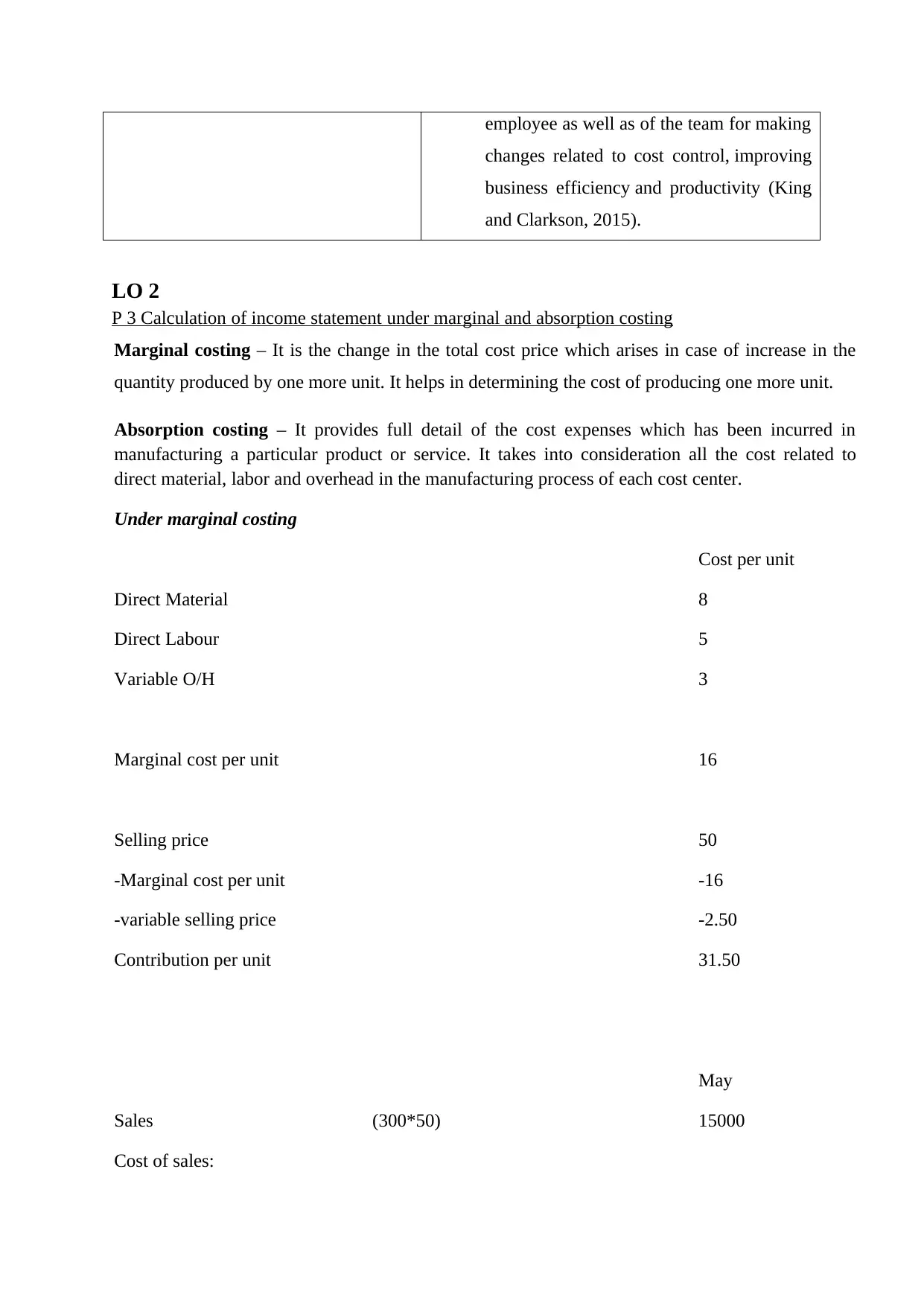
employee as well as of the team for making
changes related to cost control, improving
business efficiency and productivity (King
and Clarkson, 2015).
LO 2
P 3 Calculation of income statement under marginal and absorption costing
Marginal costing – It is the change in the total cost price which arises in case of increase in the
quantity produced by one more unit. It helps in determining the cost of producing one more unit.
Absorption costing – It provides full detail of the cost expenses which has been incurred in
manufacturing a particular product or service. It takes into consideration all the cost related to
direct material, labor and overhead in the manufacturing process of each cost center.
Under marginal costing
Cost per unit
Direct Material 8
Direct Labour 5
Variable O/H 3
Marginal cost per unit 16
Selling price 50
-Marginal cost per unit -16
-variable selling price -2.50
Contribution per unit 31.50
May
Sales (300*50) 15000
Cost of sales:
changes related to cost control, improving
business efficiency and productivity (King
and Clarkson, 2015).
LO 2
P 3 Calculation of income statement under marginal and absorption costing
Marginal costing – It is the change in the total cost price which arises in case of increase in the
quantity produced by one more unit. It helps in determining the cost of producing one more unit.
Absorption costing – It provides full detail of the cost expenses which has been incurred in
manufacturing a particular product or service. It takes into consideration all the cost related to
direct material, labor and overhead in the manufacturing process of each cost center.
Under marginal costing
Cost per unit
Direct Material 8
Direct Labour 5
Variable O/H 3
Marginal cost per unit 16
Selling price 50
-Marginal cost per unit -16
-variable selling price -2.50
Contribution per unit 31.50
May
Sales (300*50) 15000
Cost of sales:
Paraphrase This Document
Need a fresh take? Get an instant paraphrase of this document with our AI Paraphraser
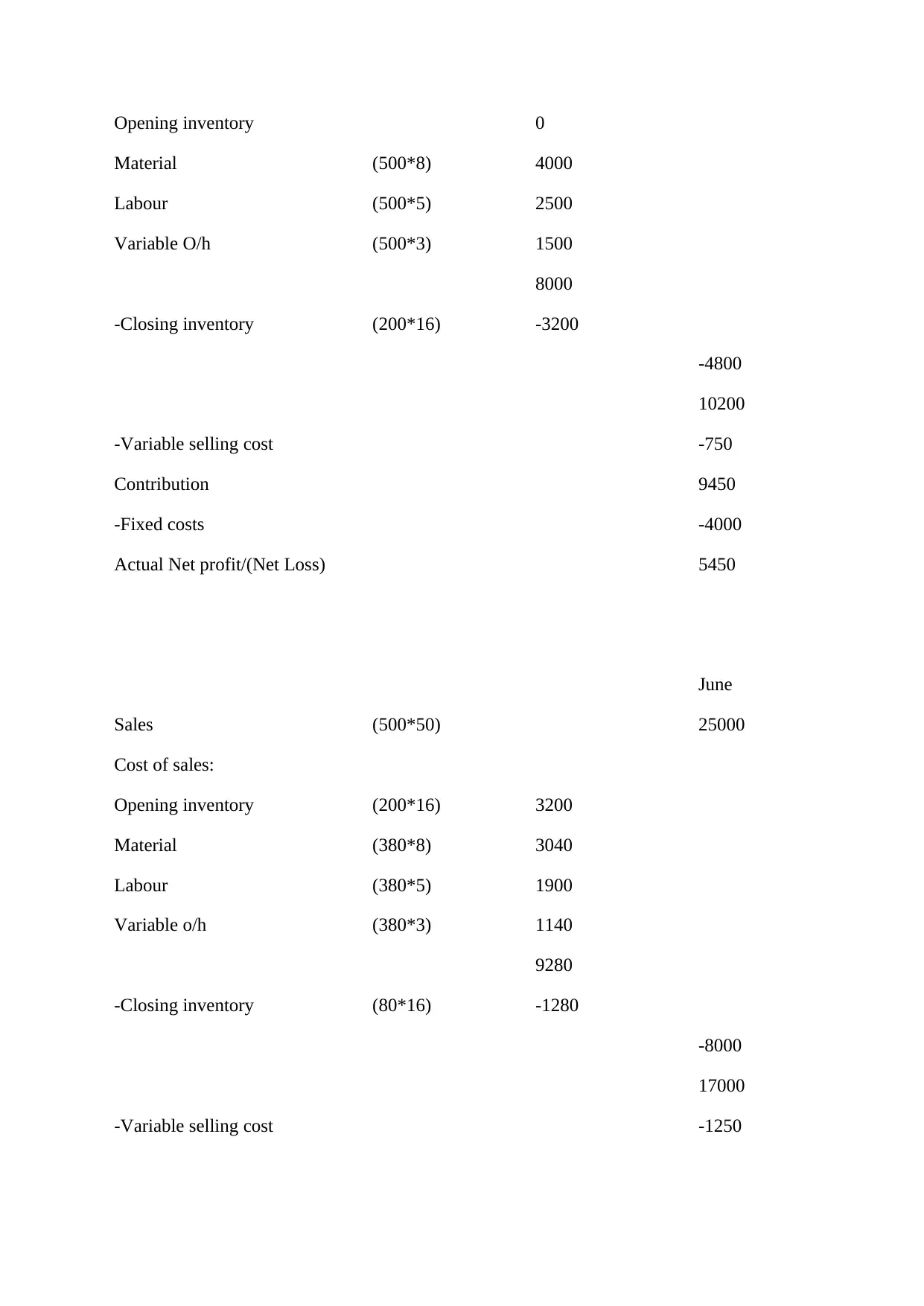
Opening inventory 0
Material (500*8) 4000
Labour (500*5) 2500
Variable O/h (500*3) 1500
8000
-Closing inventory (200*16) -3200
-4800
10200
-Variable selling cost -750
Contribution 9450
-Fixed costs -4000
Actual Net profit/(Net Loss) 5450
June
Sales (500*50) 25000
Cost of sales:
Opening inventory (200*16) 3200
Material (380*8) 3040
Labour (380*5) 1900
Variable o/h (380*3) 1140
9280
-Closing inventory (80*16) -1280
-8000
17000
-Variable selling cost -1250
Material (500*8) 4000
Labour (500*5) 2500
Variable O/h (500*3) 1500
8000
-Closing inventory (200*16) -3200
-4800
10200
-Variable selling cost -750
Contribution 9450
-Fixed costs -4000
Actual Net profit/(Net Loss) 5450
June
Sales (500*50) 25000
Cost of sales:
Opening inventory (200*16) 3200
Material (380*8) 3040
Labour (380*5) 1900
Variable o/h (380*3) 1140
9280
-Closing inventory (80*16) -1280
-8000
17000
-Variable selling cost -1250
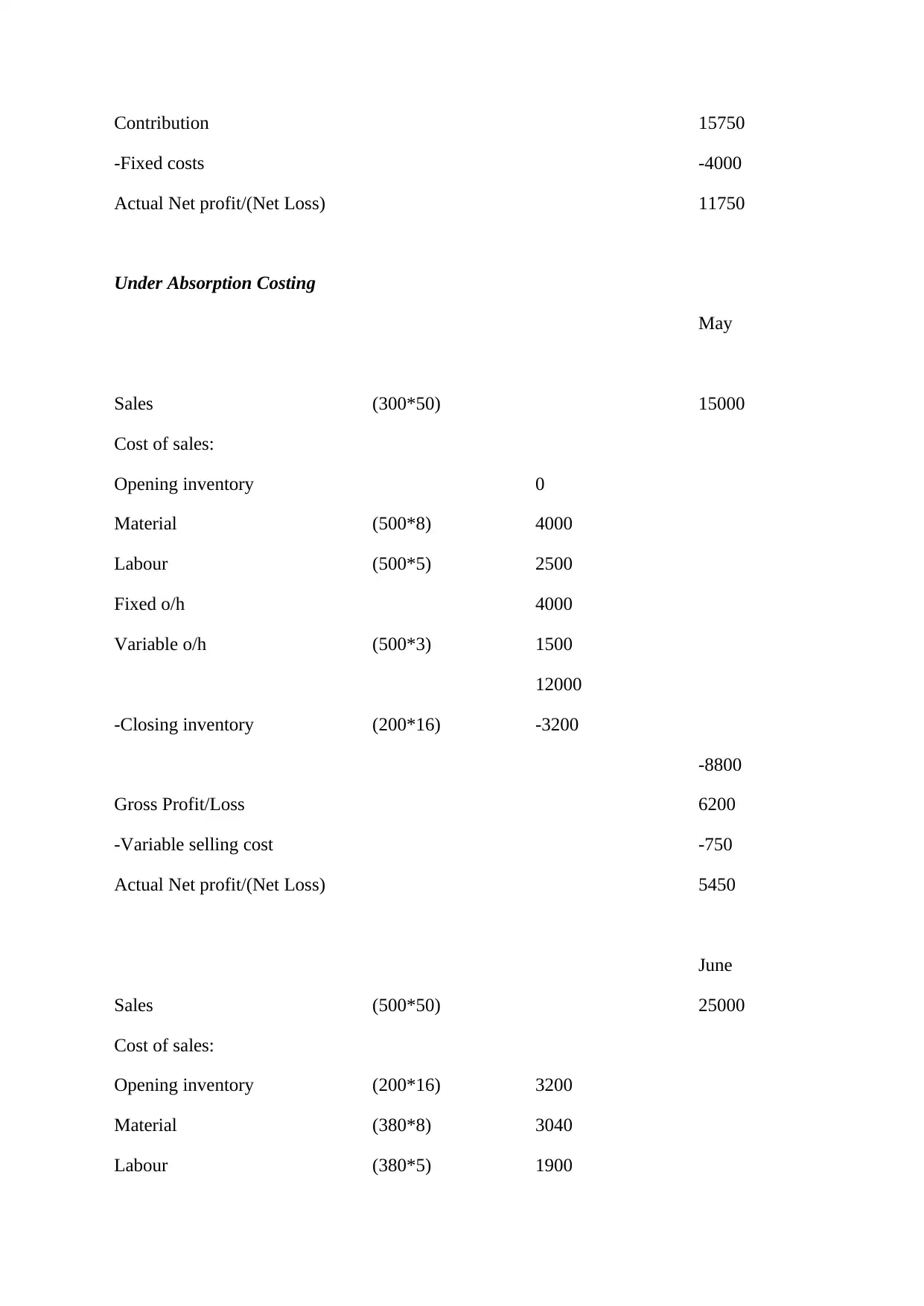
Contribution 15750
-Fixed costs -4000
Actual Net profit/(Net Loss) 11750
Under Absorption Costing
May
Sales (300*50) 15000
Cost of sales:
Opening inventory 0
Material (500*8) 4000
Labour (500*5) 2500
Fixed o/h 4000
Variable o/h (500*3) 1500
12000
-Closing inventory (200*16) -3200
-8800
Gross Profit/Loss 6200
-Variable selling cost -750
Actual Net profit/(Net Loss) 5450
June
Sales (500*50) 25000
Cost of sales:
Opening inventory (200*16) 3200
Material (380*8) 3040
Labour (380*5) 1900
-Fixed costs -4000
Actual Net profit/(Net Loss) 11750
Under Absorption Costing
May
Sales (300*50) 15000
Cost of sales:
Opening inventory 0
Material (500*8) 4000
Labour (500*5) 2500
Fixed o/h 4000
Variable o/h (500*3) 1500
12000
-Closing inventory (200*16) -3200
-8800
Gross Profit/Loss 6200
-Variable selling cost -750
Actual Net profit/(Net Loss) 5450
June
Sales (500*50) 25000
Cost of sales:
Opening inventory (200*16) 3200
Material (380*8) 3040
Labour (380*5) 1900
⊘ This is a preview!⊘
Do you want full access?
Subscribe today to unlock all pages.

Trusted by 1+ million students worldwide
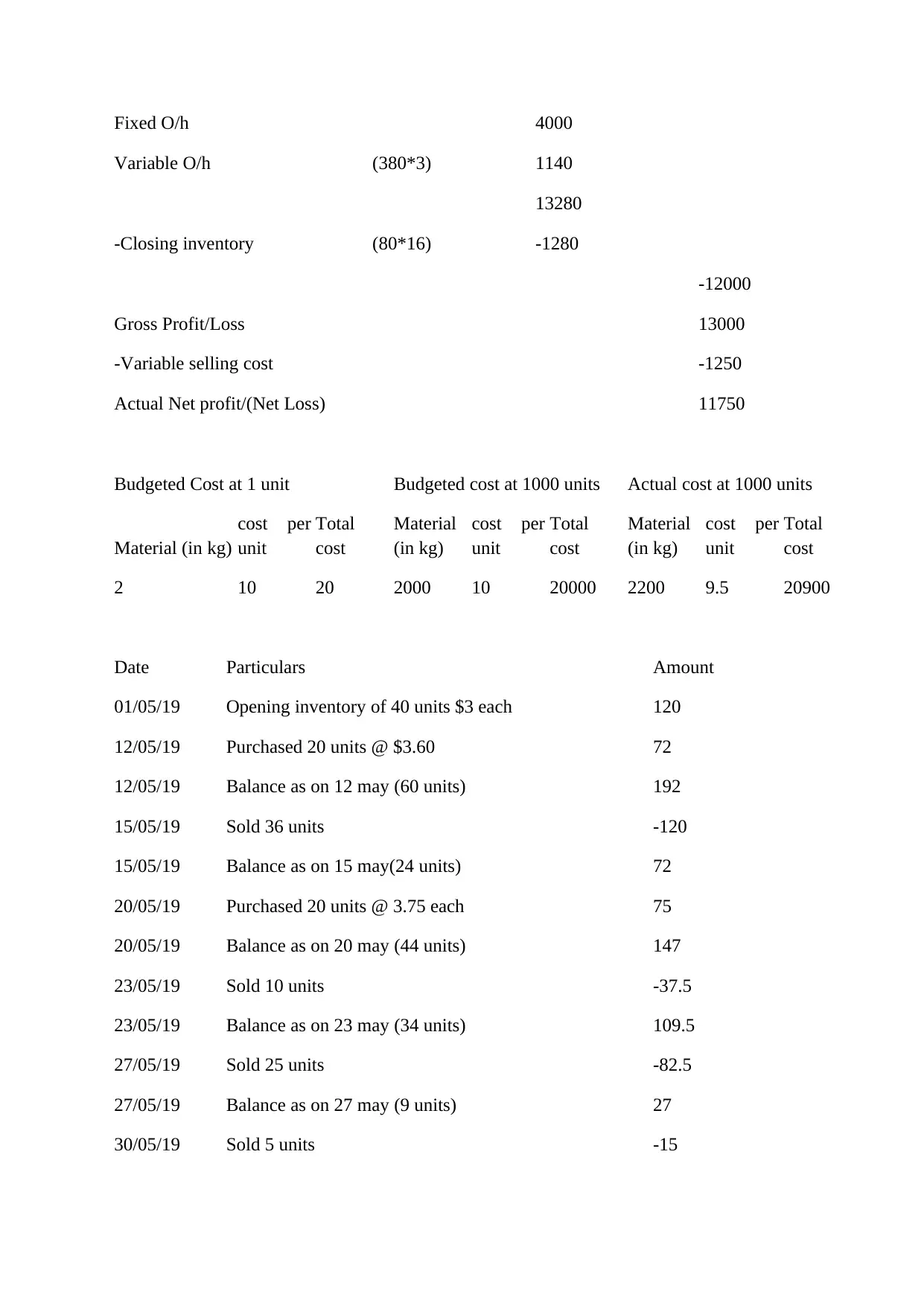
Fixed O/h 4000
Variable O/h (380*3) 1140
13280
-Closing inventory (80*16) -1280
-12000
Gross Profit/Loss 13000
-Variable selling cost -1250
Actual Net profit/(Net Loss) 11750
Budgeted Cost at 1 unit Budgeted cost at 1000 units Actual cost at 1000 units
Material (in kg)
cost per
unit
Total
cost
Material
(in kg)
cost per
unit
Total
cost
Material
(in kg)
cost per
unit
Total
cost
2 10 20 2000 10 20000 2200 9.5 20900
Date Particulars Amount
01/05/19 Opening inventory of 40 units $3 each 120
12/05/19 Purchased 20 units @ $3.60 72
12/05/19 Balance as on 12 may (60 units) 192
15/05/19 Sold 36 units -120
15/05/19 Balance as on 15 may(24 units) 72
20/05/19 Purchased 20 units @ 3.75 each 75
20/05/19 Balance as on 20 may (44 units) 147
23/05/19 Sold 10 units -37.5
23/05/19 Balance as on 23 may (34 units) 109.5
27/05/19 Sold 25 units -82.5
27/05/19 Balance as on 27 may (9 units) 27
30/05/19 Sold 5 units -15
Variable O/h (380*3) 1140
13280
-Closing inventory (80*16) -1280
-12000
Gross Profit/Loss 13000
-Variable selling cost -1250
Actual Net profit/(Net Loss) 11750
Budgeted Cost at 1 unit Budgeted cost at 1000 units Actual cost at 1000 units
Material (in kg)
cost per
unit
Total
cost
Material
(in kg)
cost per
unit
Total
cost
Material
(in kg)
cost per
unit
Total
cost
2 10 20 2000 10 20000 2200 9.5 20900
Date Particulars Amount
01/05/19 Opening inventory of 40 units $3 each 120
12/05/19 Purchased 20 units @ $3.60 72
12/05/19 Balance as on 12 may (60 units) 192
15/05/19 Sold 36 units -120
15/05/19 Balance as on 15 may(24 units) 72
20/05/19 Purchased 20 units @ 3.75 each 75
20/05/19 Balance as on 20 may (44 units) 147
23/05/19 Sold 10 units -37.5
23/05/19 Balance as on 23 may (34 units) 109.5
27/05/19 Sold 25 units -82.5
27/05/19 Balance as on 27 may (9 units) 27
30/05/19 Sold 5 units -15
Paraphrase This Document
Need a fresh take? Get an instant paraphrase of this document with our AI Paraphraser
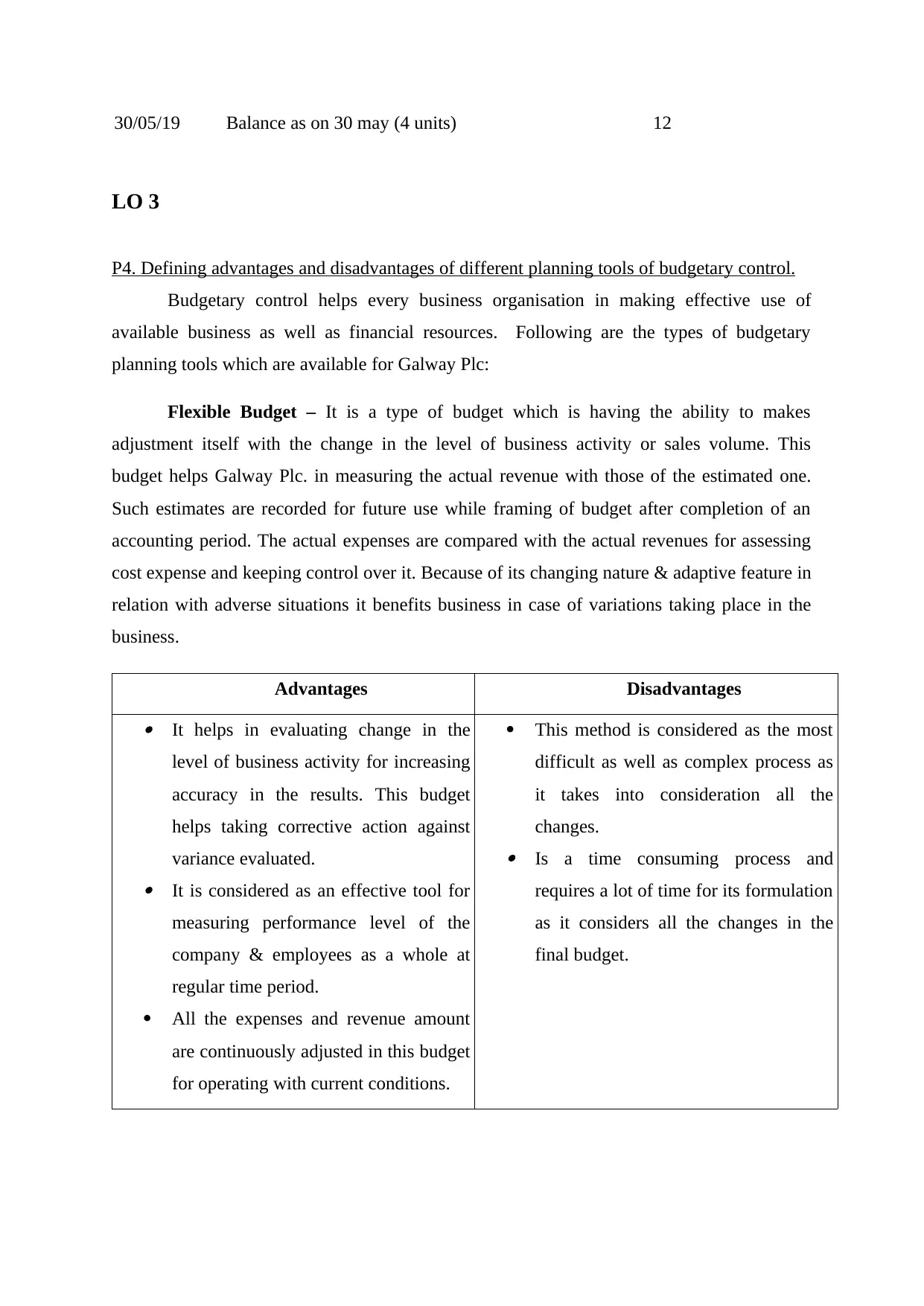
30/05/19 Balance as on 30 may (4 units) 12
LO 3
P4. Defining advantages and disadvantages of different planning tools of budgetary control.
Budgetary control helps every business organisation in making effective use of
available business as well as financial resources. Following are the types of budgetary
planning tools which are available for Galway Plc:
Flexible Budget – It is a type of budget which is having the ability to makes
adjustment itself with the change in the level of business activity or sales volume. This
budget helps Galway Plc. in measuring the actual revenue with those of the estimated one.
Such estimates are recorded for future use while framing of budget after completion of an
accounting period. The actual expenses are compared with the actual revenues for assessing
cost expense and keeping control over it. Because of its changing nature & adaptive feature in
relation with adverse situations it benefits business in case of variations taking place in the
business.
Advantages Disadvantages It helps in evaluating change in the
level of business activity for increasing
accuracy in the results. This budget
helps taking corrective action against
variance evaluated. It is considered as an effective tool for
measuring performance level of the
company & employees as a whole at
regular time period.
All the expenses and revenue amount
are continuously adjusted in this budget
for operating with current conditions.
This method is considered as the most
difficult as well as complex process as
it takes into consideration all the
changes.
Is a time consuming process and
requires a lot of time for its formulation
as it considers all the changes in the
final budget.
LO 3
P4. Defining advantages and disadvantages of different planning tools of budgetary control.
Budgetary control helps every business organisation in making effective use of
available business as well as financial resources. Following are the types of budgetary
planning tools which are available for Galway Plc:
Flexible Budget – It is a type of budget which is having the ability to makes
adjustment itself with the change in the level of business activity or sales volume. This
budget helps Galway Plc. in measuring the actual revenue with those of the estimated one.
Such estimates are recorded for future use while framing of budget after completion of an
accounting period. The actual expenses are compared with the actual revenues for assessing
cost expense and keeping control over it. Because of its changing nature & adaptive feature in
relation with adverse situations it benefits business in case of variations taking place in the
business.
Advantages Disadvantages It helps in evaluating change in the
level of business activity for increasing
accuracy in the results. This budget
helps taking corrective action against
variance evaluated. It is considered as an effective tool for
measuring performance level of the
company & employees as a whole at
regular time period.
All the expenses and revenue amount
are continuously adjusted in this budget
for operating with current conditions.
This method is considered as the most
difficult as well as complex process as
it takes into consideration all the
changes.
Is a time consuming process and
requires a lot of time for its formulation
as it considers all the changes in the
final budget.
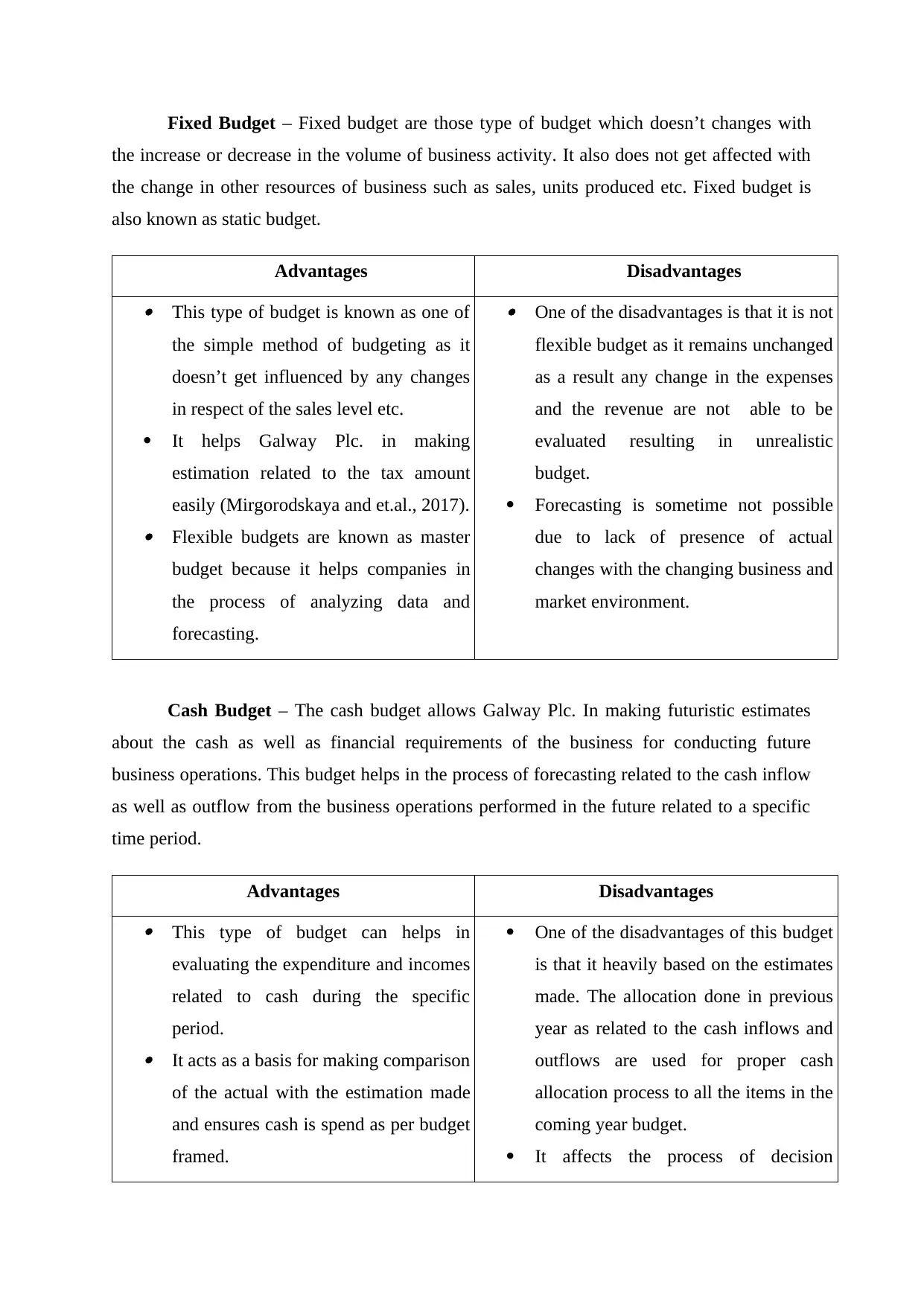
Fixed Budget – Fixed budget are those type of budget which doesn’t changes with
the increase or decrease in the volume of business activity. It also does not get affected with
the change in other resources of business such as sales, units produced etc. Fixed budget is
also known as static budget.
Advantages Disadvantages This type of budget is known as one of
the simple method of budgeting as it
doesn’t get influenced by any changes
in respect of the sales level etc.
It helps Galway Plc. in making
estimation related to the tax amount
easily (Mirgorodskaya and et.al., 2017). Flexible budgets are known as master
budget because it helps companies in
the process of analyzing data and
forecasting.
One of the disadvantages is that it is not
flexible budget as it remains unchanged
as a result any change in the expenses
and the revenue are not able to be
evaluated resulting in unrealistic
budget.
Forecasting is sometime not possible
due to lack of presence of actual
changes with the changing business and
market environment.
Cash Budget – The cash budget allows Galway Plc. In making futuristic estimates
about the cash as well as financial requirements of the business for conducting future
business operations. This budget helps in the process of forecasting related to the cash inflow
as well as outflow from the business operations performed in the future related to a specific
time period.
Advantages Disadvantages This type of budget can helps in
evaluating the expenditure and incomes
related to cash during the specific
period. It acts as a basis for making comparison
of the actual with the estimation made
and ensures cash is spend as per budget
framed.
One of the disadvantages of this budget
is that it heavily based on the estimates
made. The allocation done in previous
year as related to the cash inflows and
outflows are used for proper cash
allocation process to all the items in the
coming year budget.
It affects the process of decision
the increase or decrease in the volume of business activity. It also does not get affected with
the change in other resources of business such as sales, units produced etc. Fixed budget is
also known as static budget.
Advantages Disadvantages This type of budget is known as one of
the simple method of budgeting as it
doesn’t get influenced by any changes
in respect of the sales level etc.
It helps Galway Plc. in making
estimation related to the tax amount
easily (Mirgorodskaya and et.al., 2017). Flexible budgets are known as master
budget because it helps companies in
the process of analyzing data and
forecasting.
One of the disadvantages is that it is not
flexible budget as it remains unchanged
as a result any change in the expenses
and the revenue are not able to be
evaluated resulting in unrealistic
budget.
Forecasting is sometime not possible
due to lack of presence of actual
changes with the changing business and
market environment.
Cash Budget – The cash budget allows Galway Plc. In making futuristic estimates
about the cash as well as financial requirements of the business for conducting future
business operations. This budget helps in the process of forecasting related to the cash inflow
as well as outflow from the business operations performed in the future related to a specific
time period.
Advantages Disadvantages This type of budget can helps in
evaluating the expenditure and incomes
related to cash during the specific
period. It acts as a basis for making comparison
of the actual with the estimation made
and ensures cash is spend as per budget
framed.
One of the disadvantages of this budget
is that it heavily based on the estimates
made. The allocation done in previous
year as related to the cash inflows and
outflows are used for proper cash
allocation process to all the items in the
coming year budget.
It affects the process of decision
⊘ This is a preview!⊘
Do you want full access?
Subscribe today to unlock all pages.

Trusted by 1+ million students worldwide
1 out of 18
Related Documents
Your All-in-One AI-Powered Toolkit for Academic Success.
+13062052269
info@desklib.com
Available 24*7 on WhatsApp / Email
![[object Object]](/_next/static/media/star-bottom.7253800d.svg)
Unlock your academic potential
Copyright © 2020–2025 A2Z Services. All Rights Reserved. Developed and managed by ZUCOL.





